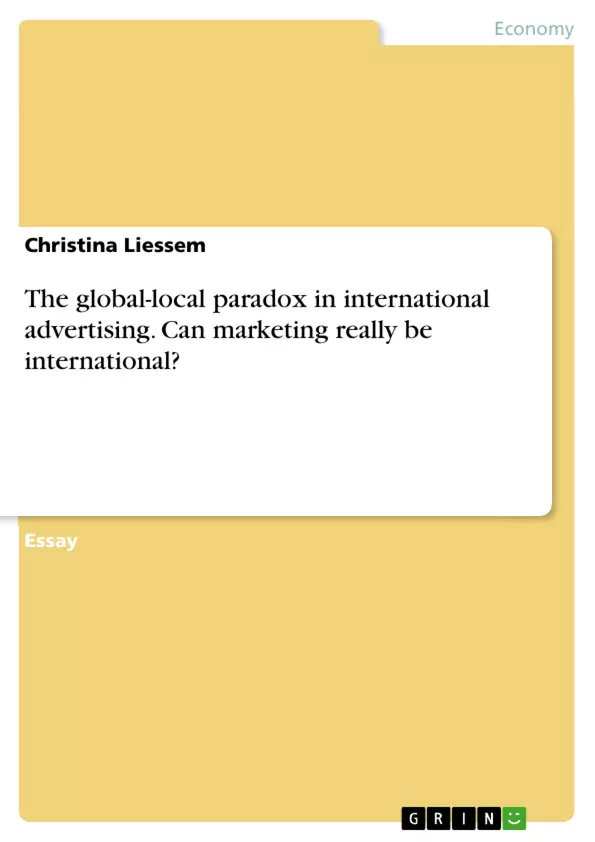The debate around standardization versus adaptation in international marketing consists since nearly half a decade now. Usunier and Lee (2009) believe that international marketing cannot be global and refer to it as intercultural marketing. De Mooij (2010:3) states that people think and act based on their inherent framework, given them by their culture and national belonging. Even if they try to think different, they will still see it out of their own cultural perspective. In de Mooij’s opinion this leads to the paradox that people are not able to think global, but furthermore see and judge their world always according to their own framework, even if they might believe they think global. In the marketing context this would mean that international marketing cannot be global. Marketers will always use their own cultural system to create advertising for other cultures, which apparently cannot be successful there. Nevertheless the debate is still in the centre of attention in international marketing. Neither academicians nor practitioners were able to give a coherent answer to the question, if global advertising can be successful or if advertising has to be adapted to local circumstances. Agrawal (1995) points out the waves of changes between adaptation and standardization advertising strategies used by practitioners between the 1950’s and the 1980’s. Simultaneously, “academicians in contrast have generally been consistent in advocating the adaptation approach and/or the contingency approach” (Agrawal, 1995:44). These results indicate that the global advertising cannot easily be doomed as an unsuccessful strategy.
This essay provides a critical review over the debate standardization versus adaptation in international marketing. Additionally case examples from German companies will be introduced to support the argumentation.
Inhaltsverzeichnis (Table of Contents)
- Introduction
- The standardization versus adaptation debate in advertising
- Standardization versus adaptation - the contingency approach
- Familiarity with the brand
- Type of product
- Advertising form
- Consumers
- Case examples
- Standardized approach: Dr. Oetker frozen pizza
- Adapted approach: Jägermeister
- Mixed strategy: Audi & Mercedes
- Conclusion
Zielsetzung und Themenschwerpunkte (Objectives and Key Themes)
This essay critically analyzes the ongoing debate surrounding standardization versus adaptation in international marketing. It explores the historical context of the debate, including the arguments for and against both approaches. The essay draws on existing academic literature and real-world examples from German companies to support its arguments.
- The evolution of the standardization vs. adaptation debate in advertising
- The influence of cultural context on advertising effectiveness
- The concept of a global consumer and its limitations
- The costs and benefits of standardization versus adaptation
- The role of the contingency approach in developing effective international marketing strategies
Zusammenfassung der Kapitel (Chapter Summaries)
The introduction provides an overview of the central topic of the essay: the standardization vs. adaptation debate in international marketing. It highlights the ongoing discussion and its importance for both academics and practitioners.
Chapter 2 delves into the historical development of the standardization vs. adaptation debate, tracing its roots back to the early 20th century. It presents key arguments for and against both approaches, examining the historical context of advertising standardization and the challenges of achieving global consistency.
Chapter 3 focuses on the contingency approach, which acknowledges that there is no one-size-fits-all solution to international advertising. It explores factors that influence the decision to standardize or adapt, such as brand familiarity, product type, advertising form, and consumer characteristics.
Schlüsselwörter (Keywords)
The key terms and concepts explored in this essay include international advertising, standardization, adaptation, contingency approach, global consumer, cultural context, brand image, consumer behavior, and marketing strategies.
- Arbeit zitieren
- Christina Liessem (Autor:in), 2011, The global-local paradox in international advertising. Can marketing really be international?, München, GRIN Verlag, https://www.grin.com/document/283946



